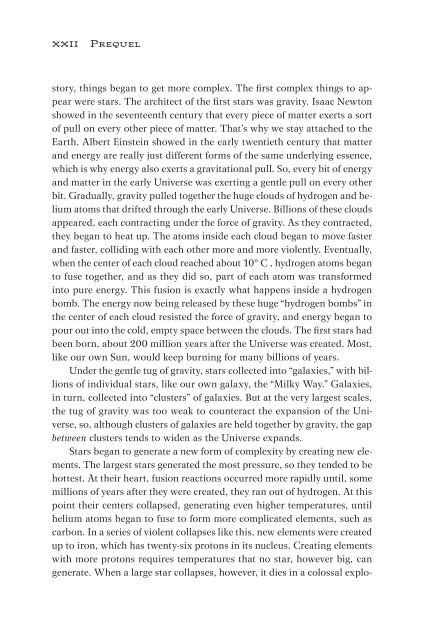This Fleeting World
This Fleeting World
This Fleeting World
Create successful ePaper yourself
Turn your PDF publications into a flip-book with our unique Google optimized e-Paper software.
xxii Prequel<br />
story, things began to get more complex. The first complex things to appear<br />
were stars. The architect of the first stars was gravity. Isaac Newton<br />
showed in the seventeenth century that every piece of matter exerts a sort<br />
of pull on every other piece of matter. That’s why we stay attached to the<br />
Earth. Albert Einstein showed in the early twentieth century that matter<br />
and energy are really just different forms of the same underlying essence,<br />
which is why energy also exerts a gravitational pull. So, every bit of energy<br />
and matter in the early Universe was exerting a gentle pull on every other<br />
bit. Gradually, gravity pulled together the huge clouds of hydrogen and helium<br />
atoms that drifted through the early Universe. Billions of these clouds<br />
appeared, each contracting under the force of gravity. As they contracted,<br />
they began to heat up. The atoms inside each cloud began to move faster<br />
and faster, colliding with each other more and more violently. Eventually,<br />
when the center of each cloud reached about 10° C , hydrogen atoms began<br />
to fuse together, and as they did so, part of each atom was transformed<br />
into pure energy. <strong>This</strong> fusion is exactly what happens inside a hydrogen<br />
bomb. The energy now being released by these huge “hydrogen bombs” in<br />
the center of each cloud resisted the force of gravity, and energy began to<br />
pour out into the cold, empty space between the clouds. The first stars had<br />
been born, about 200 million years after the Universe was created. Most,<br />
like our own Sun, would keep burning for many billions of years.<br />
Under the gentle tug of gravity, stars collected into “galaxies,” with billions<br />
of individual stars, like our own galaxy, the “Milky Way.” Galaxies,<br />
in turn, collected into “clusters” of galaxies. But at the very largest scales,<br />
the tug of gravity was too weak to counteract the expansion of the Universe,<br />
so, although clusters of galaxies are held together by gravity, the gap<br />
between clusters tends to widen as the Universe expands.<br />
Stars began to generate a new form of complexity by creating new elements.<br />
The largest stars generated the most pressure, so they tended to be<br />
hottest. At their heart, fusion reactions occurred more rapidly until, some<br />
millions of years after they were created, they ran out of hydrogen. At this<br />
point their centers collapsed, generating even higher temperatures, until<br />
helium atoms began to fuse to form more complicated elements, such as<br />
carbon. In a series of violent collapses like this, new elements were created<br />
up to iron, which has twenty-six protons in its nucleus. Creating elements<br />
with more protons requires temperatures that no star, however big, can<br />
generate. When a large star collapses, however, it dies in a colossal explo-


